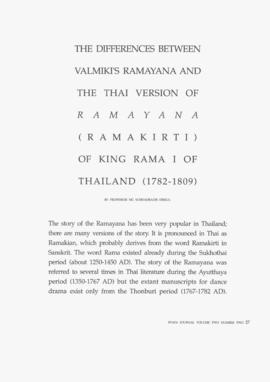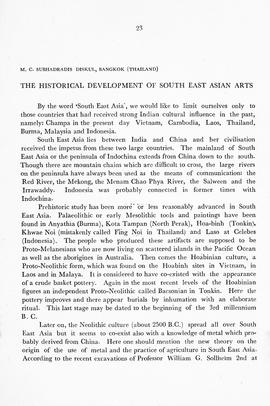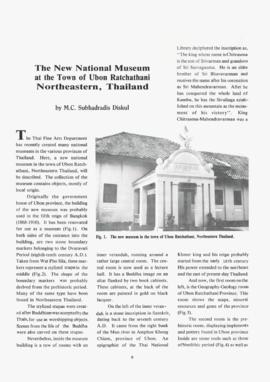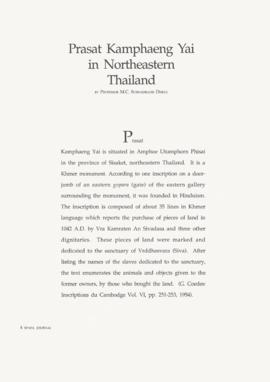พระโพธิสัตว์อวโลกิเตศวร [ตอนที่ 2]
- TH Subhadradis 02 ACAR-01-057
- Item
- 2517
Part of บทความ
ผู้เขียนเรียบเรียงจากหนังสือเรื่องพระโพธิสัตว์อวโลกิเตศวร ของ มาเรีย-เธแรส เดอ มัลมาน (Marie-Therese de Mallmann) ซึ่งมีเนื้อหาเกี่ยวกับพระโพธิสัตว์อวโลกิเตศวรในประเทศอินเดียเท่านั้น พระโพธิสัตว์อวโลกิเตศวรทรงมีลักษณะเป็นเจ้าแห่งจักรวาล ทรงเป็นเทพเจ้าที่สูงกว่าเทพเจ้าทั้งหมดและสูงกว่าพระพุทธเจ้าด้วย พระนามของพระโพธิสัตว์อวโลกิเตศวร เริ่มปรากฎมีขึ้นในคัมภีร์ราวพุทธศตวรรษที่ 6-8 รูปพระโพธิสัตว์อวโลกิเตศวรเกิดขึ้นอย่างแน่นอนในระหว่าง พ.ศ. 700-750 รูปหนึ่งอยู่ในศิลปคันธาระซึ่งได้รับอิทธิพลมาจากศิลปกรีก-โรมัน และอีกรูปหนึ่งอยู่ในศิลปของราชวงศ์กุษาณะที่เมืองมถุรา รูปพระโพธิสัตว์อวโลกิเตศวรทุกองค์ในศิลปสมัยคุปตะ และหลังคุปตะในแคว้นมหาราษฎร์และดินแดนใกล้เคียง มักมีลักษณะเกือบคงที่ตั้งแต่ พุทธศตวรรษที่ 11-13 คือ ทรงเครื่องแต่งองค์อย่างเรียบ ๆ เกศาเกล้าเป็นชฎามงกุฎไม่มีเครื่องประดับ เครื่องอาภรณ์มีน้อย แต่ประติมาณวิทยาทางภาคตะวันออกของประเทศอินเดีย ตั้งแต่ราวพุทธศตวรรษที่ 10 เริ่มทรงเครื่องอาภรณ์แล้ว มีการศึกษารูปต่าง ๆ ของพระโพธิสัตว์อวโลกิเตศวร ตั้งแต่พระโพธิสัตว์อวโลกิเตศวร 6 กร ในสมัยแรกของศิลปปาละ-เสนะ พระโพธิสัตว์อวโลกิเตศวร 4 กร ซึ่งปรากฏขึ้นบ่อย ๆ ตั้งแต่สมัยเสื่อมชั่วคราวจนถึงสมัยฟื้นฟู และพระโพธิสัตว์ 2 กร ซึ่งมีอยู่ตลอดระยะเวลาของศิลปปาละ-เสนะ รวมทั้งพระโพธิ์สัตว์อวโลกิเตศวร 12 กร และ 16 กร.
ศ. ม.จ. สุภัทรดิศ ดิศกุล

![พระโพธิสัตว์อวโลกิเตศวร [ตอนที่ 2]](/uploads/r/the-repository-of-professor-m-c-subhadradis-diskul/2/7/7/2772dc6574e1356a3138ec4609469ce256471ae15c602fc5228b836fefa9cd7c/ACAR-02-01-057Avalokitesvara2.jpg)
![พระโพธิสัตว์อวโลกิเตศวร [ตอนที่ 3]](/uploads/r/the-repository-of-professor-m-c-subhadradis-diskul/d/b/0/db0054f00aab6259c4c59ef5b9e419ab1e17e1d5c1a91667330469b103cafc13/ACAR-02-01-058Avalokitesvara3.jpg)
![พระโพธิสัตว์อวโลกิเตศวร [ตอนที่ 4]](/uploads/r/the-repository-of-professor-m-c-subhadradis-diskul/0/1/a/01a3731cd385acd0e208931bad0160e4e5ebbb93e406c363d76f4485e84ab093/ACAR-02-01-059Avalokitesvara4.jpg)






